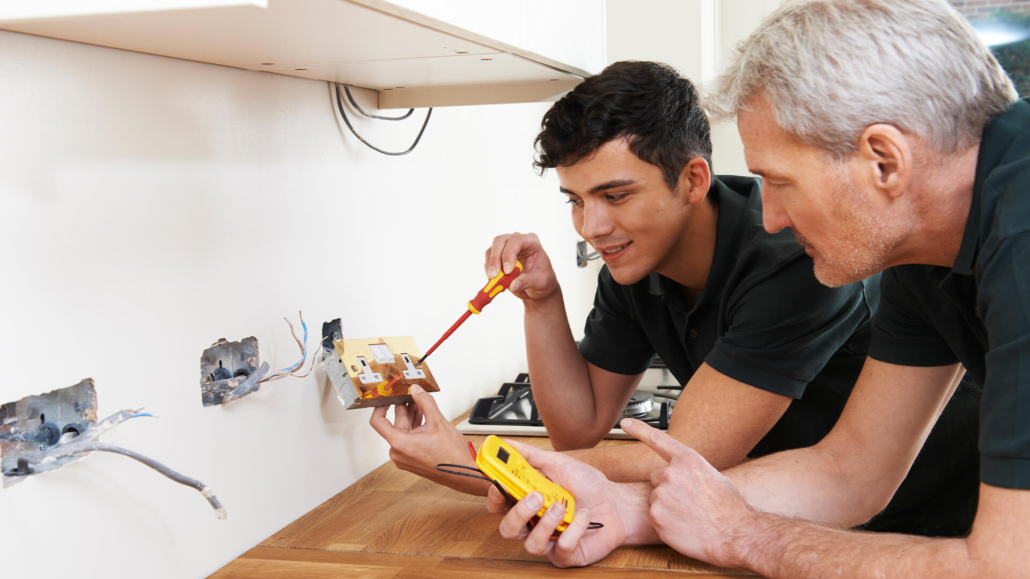As a business owner, you may often find yourself in conversations with electricians or reading articles related to electrical systems, but some of the terminology might leave you feeling a bit lost. Fear not! At Archon Electrical Services, we’re here to help you understand some of the most common electrical terms so you can make informed decisions about your business’s electrical needs. In this friendly guide, we’ll demystify some key terms and concepts to help you better understand the world of electrical systems. Whether you need electrical repairs done, appliances installed, a lighting upgrade, or a new security system, we want you to feel confident when speaking with your electrician. So, let’s dive right in!
20 Common Electrical Terms Explained in Simple Language
Voltage (V)
Voltage is the force that pushes electric current through a conductor, such as a wire. It’s often compared to the pressure of water flowing through a pipe. The higher the voltage, the greater the force pushing the current. In Australia, the standard voltage for commercial and residential properties is 230 volts.
Current (A)
Current, measured in amperes (A), is the flow of electrical charge through a conductor. It’s similar to the flow of water through a pipe. The more current that flows, the more power is being transmitted.
Resistance (Ω)
Resistance, measured in ohms (Ω), is the opposition to the flow of electric current in a conductor. Just as a narrow pipe restricts the flow of water, a conductor with high resistance restricts the flow of electric current.
Power (W)
Power, measured in watts (W), is the rate at which electrical energy is used or produced. It’s the product of voltage and current, and it indicates the amount of work that can be done by an electrical system.
Circuit Breaker
A circuit breaker is a safety device that automatically shuts off the flow of electricity in a circuit when it detects an overload or short circuit. This helps prevent electrical fires and damage to equipment.
Grounding (or Earthing)
Grounding, also known as earthing, is a safety measure that connects an electrical system to the earth. It provides a path for excess current to safely flow to the ground, preventing damage to equipment and reducing the risk of electrical shocks.
RCD (Residual Current Device)
An RCD, or residual current device, is an electrical term for a type of circuit breaker that protects against electrical shocks by quickly shutting off the power when it detects an imbalance in the flow of current between the live and neutral conductors. RCDs are commonly installed in areas where water is present, such as kitchens and bathrooms.
Single-phase vs. Three-phase Power
Single-phase power is the most common type of electrical service for residential and small commercial properties. It uses one alternating current (AC) waveform. Three-phase power, on the other hand, uses three AC waveforms and is typically found in larger commercial and industrial settings. It’s more efficient for heavy-duty applications, such as powering large motors and heavy machinery.
Energy Efficiency
Energy efficiency refers to the ability of an electrical device or system to perform its function while using as little energy as possible. Energy-efficient equipment can help businesses save money on their energy bills and reduce their environmental impact.
Smart Meters
Smart meters are advanced, digital electricity meters that measure and record your energy consumption in real-time. They provide detailed information on how much energy you’re using, enabling you to monitor and optimise your energy consumption and potentially save money on your energy bills.
Mains Power
Mains power refers to the primary electrical supply coming from the utility provider, which powers all the electrical devices and appliances in your business. In Australia, mains power is typically supplied as 230-volt, single-phase or 400-volt, three-phase alternating current (AC).

Our team of licensed electricians in Melbourne can assist with all your electrical needs, from switchboard upgrades to installations and repairs.
Switchboard
A switchboard is the central hub where all the electrical circuits within your business are connected. It houses circuit breakers, fuses, and residual current devices (RCDs) to protect and manage your electrical system safely and efficiently.
GPO (General Purpose Outlet)
A GPO, or general purpose outlet, is a common term in Australia for a standard electrical socket or power point where you plug in your appliances and devices. These outlets usually provide single-phase power at 230 volts.
Load
Load refers to the total amount of electrical power being consumed by all devices and appliances connected to an electrical system at any given time. It’s important to manage the load on your system to prevent overloading and potential damage.
Conduit
A conduit is an electrical term for a protective tube or pipe that encases electrical wires or cables, providing a safe route for them to run through your business. Conduits can be made of various materials, such as metal, plastic, or PVC, and help protect the wiring from damage, moisture, and external elements.
Transformer
A transformer is an electrical device that changes the voltage and current levels of an alternating current (AC) supply. They are used to step up or step down the voltage, depending on the requirements of the electrical equipment being powered.
Inverter
An inverter is a device that converts direct current (DC) from sources like solar panels or batteries into alternating current (AC) to power your business’s electrical appliances and devices. Inverters are essential for renewable energy systems and off-grid power solutions.
Electrician’s License
An electrician’s license is a legal requirement for anyone performing electrical work in Australia. It ensures that the electrician has the necessary skills, qualifications, and experience to perform electrical work safely and competently. Always engage a registered electrical contractor and get a Certificate of Electrical Safety (COES).
kWh (Kilowatt-hour)
A kilowatt-hour (kWh) is a unit of energy used to measure your electricity consumption. It represents the amount of energy consumed by a 1,000-watt appliance running for one hour. Your electricity bill is usually based on the total number of kilowatt-hours used during a billing period.
Energy Rating
The term ‘energy rating’ is one of the more commonly known electrical terms. It’s a label found on electrical appliances, indicating their energy efficiency. The rating system uses a series of stars, with more stars representing higher efficiency. Choosing energy-efficient appliances with higher star ratings can help Australian businesses save on energy costs and reduce their environmental impact.
Smart Devices
Smart devices are electronic gadgets or appliances that have built-in connectivity and advanced features, enabling them to communicate, exchange data, and be controlled remotely via a network, typically through Wi-Fi or Bluetooth. These devices can be integrated into a smart home or business automation system, allowing users to monitor and control various aspects of their environment, such as lighting, heating, cooling, and security. Smart devices offer several benefits, including improved energy efficiency, enhanced security, and increased convenience for users.
Licensed Electrician in Melbourne
We hope this guide has helped clarify some common electrical terms and concepts. At Archon Electrical, we’re always happy to answer any questions you may have and provide expert advice on all your business’s electrical needs. Don’t hesitate to reach out to our friendly team for assistance or guidance.



